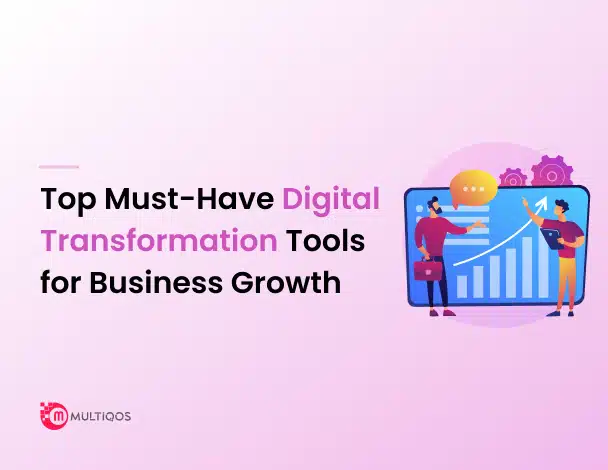Top Digital Transformation Statistics & Trends in 2025

Table of Contents:
- Introduction
- Digital Transformation: Market Trends & Future Insights
- Industry-Specific Digital Adoption Stats
- Boosting Your Business: Power & Strategies of Digital Transformation
- Business Transformation in the Digital Era
- Digital Innovation: Transforming Customer Experience
- Navigating Challenges in Digital Transformation
- Future Insights on Digital Transformation Trends
- FAQs
In the current dynamic business environment, the speed of digitalization is not only informed by speed – it is informed by urgency. These facts present evidence of how organizations, not only sustain but are growing their income through successful firms’ digitization undertakings.
Therefore, the question: In today’s world of a steadily rising pace of digital evolution, can your organization guarantee to sustain a competitive advantage through perpetuated recruitment and retention of digitally skilled professionals?
Let’s consider the following trends and statistics that would help us to understand the importance of digital change initiatives in today’s business environments across industries. These are intended to give you a novel perspective on its omnipresence and to stress the need to adapt to the new IT environment to succeed.
Captivating Insights into Digital Transformation: Market Growth, Adoption Trends, and Future Projections
- The globalization of the digital transformation market is rapidly growing with the market expected to rise from $469 billion. 8 billion in 2020 to a whopping $1,009 billion in 2021. 8 billion by 2025, which is estimated to grow at a CAGR of 16%. 5%. But that’s just the beginning.
- According to Statista, striking global spending on digital transformation is expected to hit $3. 4 trillion by 2026. That is in line with the growth of the market as Markets and Markets estimated that the market is set to rise from $521. From $95.5 billion in 2021 to $127.? From 5 billion in 2026 has been estimated to have a compounded annual growth rate of 19%.
- This projection shows that global spending is projected to reach 3 wherein the influence of digital transformation gets emphasized even more. Estimated to be worth 4 trillion U. S. dollars by the year 2026 from their current value of a little under 4 trillion U. S. dollars. Additionally, according to the studies, organizations with CDOs who show proactivity are six times more likely to achieve their objectives related to digital transformation.
- The World Economic Forum has estimated that digital transformation is likely to bring an additional $100 trillion investment in the global economy by 2025. Such interactions through the platform are believed to generate a proportion that equates to roughly two-thirds of value so colossal.
- Statista also says that planned global investment in digital transformation is expected to increase from $1. To check this drain, the country spent $7. 8 trillion in 2022 and this will reduce to $2.8 trillion by 2025. Such investments are primarily, or 51% of DT programs, dictated by growth opportunities and 41% by competitive threats, according to Prophet.
- New technologies as we will see are at the center of this revolutionary change. According to IDC, by 2025 artificial intelligence will be embedded in at least ninety percent of new enterprise applications. On the same note, Research and Markets does project that the spending on AR and VR is the fastest growing up to 2025 though IoT held the biggest share in digital transformation spending in 2019.
- Currently, the share of the digital economy in international GDP stands at 17%, but, according to analysts’ forecasts, it will exceed 20% by 2026. The market for digital transformation with a growth rate of 23% is expected to be worth $3. 3 trillion by 2025. Prospective analysis for this market is that it should develop with the expectation of a CAGR of 23 % in the future. 1%, reaching $3,810. 05 billion by 2030.
- While organizations adjust to this phenomenon, the worldwide digital transformation market is predicted to rise from $594. 5 billion in 2022 to $1,548. 9 billion by 2027 with a Compound Annual Growth Rate (CAGR) of 21 percent. 1%. These figures bring to light why it is paramount that companies adapt to the digital environment to remain relevant in today’s fluid environment.
Industry-Specific Digital Adoption: Trends and Statistics
CEOs and CIOs of different sectors have realized that digital transformation is now a competitive imperative that has to be embraced to fuel growth and propel an organization toward real or perceived profitability.
Besides improving efficiency and productivity, the shift from the conventional methods of management to hybrid, cloud, or other structures promotes the possibility of minimizing operating costs. Below are some key statistics showcasing how digital transformation has reshaped specific industries: Below are some key statistics showcasing how digital transformation has reshaped specific industries:
Retail
- The global digital transformation market in retail in 2020 is evaluated to be $143 billion. 55 billion with a growth rate of 18 anticipated in the future. 2% CAGR by 2026. The Asia-Pacific region is leading this growth, thereby underlining the high pace of digital trend implementation in retail. (Mordor Intelligence)
- Out of all the retailers 63% are upping their spending on data analysis, with 35% singling out AI software to optimize operations and improve decision-making. (Gartner)
- Of the retail executives, a whopping 71% acknowledge digital transformation as important for their technological portfolio. (Fujitsu)
- Thus, about 75% of Internet users in the United States opt for purchases through the Internet due to the convenience and individual focus that has been a result of digitalization. (Mordor Intelligence)
- These numbers show how Digital Strategy has changed retailing for the better and to provide ground for more advancement in the future.
Healthcare
- Health care is one of the sectors that are quickly embracing digital transformation with Germany, the U. S, and China being among the leading countries. The global healthcare market is anticipated to digitize at a value CAGR of over 14% during the forecast period 2021 future till 2031. (Future Market Insights)
- In the US alone, it is calculated that $250 billion and potentially 20% of current health spend is ready to move to the virtual care space. (McKinsey)
- Inter-specialty communication systems have been expanded with telehealth and telemedicine increasing from the pre-pandemic 11% to the 76% range. (McKinsey)
- It is expected that by 2025, more than $34 billion will be generated in terms of revenues from healthcare technologies and services powered by AI. (BusinessWire)
Financial Services
- In particular, reflecting the impact of COVID-19 on the overall economy, there has been a slowdown in business activities, however, such sectors as fintech services and infrastructure demonstrate high growth rates due to intensified digitalization. (Probe Group)
- New technologies are also changing the banking and insurance sectors as well. Research carried out by Cornerstone Advisors identified that 74% of the normal retail banks and credit unions are already in progress in their embracing digital transformation and 15% are planning for their strategies for implementation by 2022. (Forbes)
- According to the insurance industry trends by 2025, the majority of insurance processes would be automated by using AI and machine learning to minimize the bottlenecks in the insurance workflows. (McKinsey)
Human Resources
- Digital transformation is transforming HR, whereby, with the increase in automation of jobs in the future, an estimated 29% of existing vacancies will be eradicated while, on the contrary, job offers posted online have increased by 13%. (Forrester)
- Still, 55 percent of employers say that this is a significant barrier to innovation: lack of digital skills. (PwC)
- Moreover, as the trends show, usage of AI in HR functions has recently become rather widespread, with 58 percent of HR leaders identifying growth in overall productivity, and 16 percent using it to gain better insights. (Statista)
Manufacturing
- What is more, the current development rate clearly shows that the manufacturing sector is currently undergoing a huge digitization process. In 2020 the market size was $263 billion and is expected to be $767 billion by 2026, with the market having a CAGR of 19%. From 2021 to 2026, this segment is expected to reach 48 percent. (Mordor Intelligence)
- System downtime, that is, disruption of business operations, is a costly affair in manufacturing organizations. Citing a survey conducted by ITIC, 86 percent of the manufacturing organizations retorted that a single hour of downtime is costly, with the figure being more than $ 300,000.
Elevating Your Business: Digital power and other casts of digital transformation as well as effective strategies
Change is not just the new business mantra of the current world; it’s the reality of the new world that is driven by technology. The use of digital technologies improves performance, increases customer value, and optimizes and creates new and sustainable sources of revenues with continuous experimenting and learning from data.
Technological interventions have hence emerged as the major competitive drivers of contemporary organizations, and analysis of the implications of digitalization is therefore critical. The following are some more facts and useful information that may help highlight the advantages and thereby ensure that you have an easier understanding of why you ought to embrace going digital.
- Increased Revenue: In a Gartner study conducted among CEOs, 56% mentioned that digital advancements have positively impacted revenue.
- Adopting Digital Strategies: Significantly, digital-first has already been adopted by 89% of the companies currently or in the future bringing into focus the awareness about the strategy.
- Leadership Engagement: McKinsey further opines that the chances of companies with an engaged active Chief Digital Officer are 1%. Several studies reveal that organizations committed to digital transformation four to six times are more likely to obtain favorable outcomes.
- Post-Pandemic Business: Taking into consideration the forecast published by PwC, 70% of business managers assume that COVID-19 will turn into an endemic, making it even more crucial to build strong digital initiatives.
- Customer Experience: Adobe’s data reveal that organizations that are committed to creating better customer experiences face increases in satisfaction rates by 6 times and leads to almost double the industry average order values.
- Strategic Importance of Data: By what near predictable time will Gartner state that 90 percent of corporate strategies will have information integrated into them as a business value, with analytics seen as a competitive skill?
- Integrated Strategies: According to a survey by Alida which used to be known as Vision Critical, 39% of high-performing organizations have a fully connected digital and physical approach, hence emphasizing the need for a connected strategy.
These figures and trends prove the need for digital transformation and give a precise example of how solutions based on the use of technologies can contribute to the development of companies. Thus, by embracing these best practices, your company will not only stay afloat but succeed in the world of continuous changes.
Embracing the Digital Wave: Business Transformation in the Modern Era
At present, companies know that thriving in the market means having a solid digital presence, one that has to be built and adjusted for in the modern world. That is so true as many companies are still groping in the dark in terms of digital transformation, but the effects are already visible. This paper identifies the following trends and statistics that show how digital transformation is infiltrating the business world as follows.
The Digital Imperative: Why a Strong Digital Strategy is Non-Negotiable
- Widespread Digital Initiatives: According to Gartner, 91% of enterprises are currently participating in some sort of digital venture, and 87% of executives state that digital transformation is important.
- Digital-First Approaches: In the current business world, digital-first is central and 89% of firms have implemented a digital-first strategy or are in the process of doing so.
- COVID-19 Business Impact: Statista stated that the two most important goals that CEOs in the current pandemic sought to achieve were the promotion of digital initiatives at 37% and improving remote work at 37%.
- AI-Driven Data Usage: According to Gartner, within the next three years, artificial data that is used to train AI will be 60 percent, up from a paltry 1 percent of all data in 2021.
- Leadership in Digital Transformation: Business leaders have been presented with the information that 28% of digital transformation projects are handled by CIOs, while CEOs are getting more involved in the leadership of 23% of such projects.
- Adaptability Through Digital Platforms: Expectedly, by the year 2025, business executives will increase and apply digital platforms in mainly shifting into new markets and industries.
- Composable Business Strategy: By 2024, 60% of mainstream enterprises will adopt the composable business approach to outcompete rivals by 80% in delivering the new features’ speed.
The Cloud Revolution: Driving Innovation and Efficiency
- Growth in Cloud Security: Analyzing emerging technologies and estimating their trends to become mainstream, Gartner also predicts that the global cloud security market will grow from $40 billion in 2023 to $62 billion: Introduction of new business models that are propelled by developments in Artificial Intelligence and other advanced technologies hold great potential to create new commerce value-added chains worth 7 billion of global e-commerce revenues in 2023. 9% from reaching $5.9 billion in 2023 to $9 billion in 2028.
- Healthcare Cloud Expansion: In a business wire Technavio forecast points out that the cloud market in healthcare is likely to surge by $25. 54 billion by 2024.
- Investment in AI: According to Markets and Markets, AI spending was $ 58. 3 billion in the year 2021 to about $309 bn in the year 2022 as estimated as shown below; 6 billion by 2026.
- Cloud Storage Market Boom: The Global Cloud Storage Market has been analyzed by Fortune Business Insights and is expected to reach $390 billion from 2021 to 2028.
- Industry Cloud Platforms: It is expected that by 2027 at least 50% of enterprises will adopt industry-specific cloud platforms to help boost their business operations.
- From all these statistics and insights, it is evident that issues of digital transformation play a significant role in the current business environment. It indicates that the companies who understand and pay serious attention to the advances of digital are in a much better place to evolve and even revolutionize these environments as well as sustain themselves in these environments as they transit to further digital environments.
Transforming Customer Experience: Digital Innovation in Action
In the very competitive environments that organizations and companies currently face, they require all the edge they can get. Improving customer satisfaction is among such strategic benefits. Digital disruption or digital transformation as it is simply called brings the customer into the middle of the focus and the following information showcases how organizations are now transforming their customers’ engagement through technology.
Reinventing Customer Experience Systems: A Data-Driven Approach
- Focus on Customer Touchpoints: According to Prophet, 54% of companies’ DT initiatives are related to the renewal of customer interfaces, and 45% are about enabling platforms. However, 41 percent of companies lack deep analysis and understanding of customers and, as a result, they invested in the wrong things.
- Growth in Customer Experience Management: It is expected that the customer experience management market is going to have a high compound annual growth rate with a current worth evaluation of $11. from $55 billion in 2022 to $29.78 billion by 2028.
- Driving Digital Transformation: Even as per the Global Digital Trust Benchmarks study conducted by the business consulting firm PwC, close to 46% of the organization’s main drivers for going for digital transformation are to enhance customer experience and satisfaction.
- The Impact of Poor Experiences: What is worse, just one bad interaction can be expensive: a whopping 86% of them will turn their back on the brand they patronized previously.
- Omnichannel Excellence: Designing a customer experience with little to no breaks
- Investing in Omnichannel Strategies: Omnichannel experiences have redirected more than 80% of companies, even though five years ago was in the 20%, according to the PwC.
- Retailers Embrace Data and AI: About 63% of respondents for retailers said they intend to raise their investment in data analytics and business intelligence while 35% said they would be using artificial intelligence to improve customers’ experience.
- The Digital Divide in Retail: Business Tech further notes that those sweeping retail companies into the new wave of digital are set to gain high rewards on customers’ loyalty and high sales returns. On the other hand, those who are slow to embrace digital solutions stand a chance of being left behind in a constantly growing economy.
Most of these revelations show that digital transformation is not a mere technology transformation but a strategic value addition to customer experience. The modern consumer expects businesses that they interact with to be available across multiple touchpoints, to invest in omnichannel, and to leverage data to create better customer relationships, therefore, the need to adopt data-driven customer touchpoints to sustain businesses in the digital economy.
Overcoming the Obstacles: Navigating Digital Transformation Challenges
Digital transformation is a process that should be understood not as a one-time solution to the existing problems. It is also important to note that the level of an organization’s digital adoption is not a one-off process and the break or integration of digital technology into its daily workflow needs strategic initiatives and fundamental time and resources.
Below are some of the most pressing challenges that businesses face when embracing digital transformation: Below are some of the most pressing challenges that businesses face when embracing digital transformation:
- Size Matters: Organizations with employees of 100 or less are seven times more likely to deliver digital transformation effectively than companies having more than 50,000 employees.
- Skill Gaps: According to the 2021 OKTA survey of over 3,000 IT specialists, 54% said that this is the biggest obstacle to their digital transformation: lack of “IT skills or transformation expertise”.
- Complexity in Manufacturing: Whilst manufacturing brands are not new to globalization, digitalization is a massive challenge for them. About 76% of the companies consider the process to be somewhat too highly challenging, mainly because of the implementation complexity.
- High Upfront Costs: Investment issues are paramount, where seventy-five percent of the firms said that the costs of initiating digital change, time consumption, and the ability to get appropriate people are hurdles to the transformation.
- Talent Shortage: Approximately 30% of CIOs anticipate challenges in identifying and recruiting or developing the right data science and cybersecurity talent to advance digital programs.
- Resistance to Change: Resistance to change and the absence of a skilled workforce for digital transformation are still the leading challenges for companies.
- These challenges point to the pertinence of strategic management and the fact that business needs to keep in mind that digital transformation comes with its measures.
Embracing the Future: Insights from Digital Transformation Trends
The digital transformation industry is on the cusp of reaching further growth with key enablers such as Artificial Intelligence, Machine Learning, and Cloud Computing. The figures which were discussed above give a clear picture of the path of digital evolution in different fields.
For all the difficulties that might be faced – restrictive budgets, fierce opposition to change – there is no better time for such-process digital transformation to improve productivity, upgrade customer satisfaction, and to increase operating capability. This has made companies across the globe adapt and incorporate digital themes.
Thinking about starting your digital transformation services? Call the professionals at MultiQoS to learn how our unique tech services can help your business navigate this transition!
FAQ onDigital Transformation Statistics & Trends for 2024
Digital transformation is no longer about the ‘if’ but the ‘how’, and ‘how soon’ for businesses today. Consumers expect smooth and efficient digital communication and where such expectations are not met by firms, the latter is at risk of losing market share to others. Besides, DX helps organizations become more effective by cutting costs and optimizing business processes. Management of dispersed teams has become more important with the advent of the new type of work called remote work. For that reason, the threats in the cyber world are increasing day by day, and DX is equipped with enough security solutions for safeguarding crucial data and establishment.
Digital transformation indicates that about 70% to 95% of these projects fail and there are several reasons behind it. There, of course, are constraints such as limited budget and antipathy to change, but there are others as well. Most companies complain of issues such as legacy systems, increased IT environments, and scarcity of talent. Also, one can mention that several organizations do not link initiatives in the field of digitalization with other organizational objectives and thus, end up with miscommunication of objectives. Inadequate engagement of stakeholders and a failure to define success criteria are also other factors that lead to frequent DX failure.
According to research, at present only one-third of the organizations can say that they have implemented digital transformation properly or are in the process of it.
The digital transformation process is a very dynamic one and the following trends are then defining the future. AI and ML can be employed in business processes as they are being integrated progressively into industries. Sophisticated solutions are being cloud-based for scalability and work operation flexibility, whereas Hyper-automation is being implemented as it increases the manifold of workflow. Real-time data processing with edge computing is becoming more prevalent, while no-code/low-code applications are allowing people who are not programmers to contribute to the development of applications and solutions, making development much faster.
To be digital is not easy and the journey of achieving a digitized organization comes with its difficulties. Employees’ reluctance to change their ways of working is another, as well as problems with implementing new technologies to existing ones. Lack of proper data management and control and security threats are also other forms of threats. Thus, to counter the above impediments, change management has to be made a priority together with upskilling the employees alongside embracing the latest technological trends in a learning organization.
As shown in this paper, the levels of companies’ transition to digital transformation also differ greatly across sectors. These sectors are at the forefront since technology is core business as can be seen in sectors such as IT and finance. The retail and healthcare industries act as examples of industries that are quickly incorporating digital services into the shopper’s experience. At the same time, digital technologies are gradually penetrating such sectors as manufacturing or construction. Regulatory drivers and established systems lag that impact the speed and the manner in which various industries are transformed cannot be uniform.
Get In Touch






